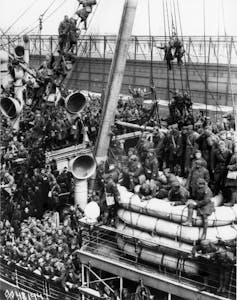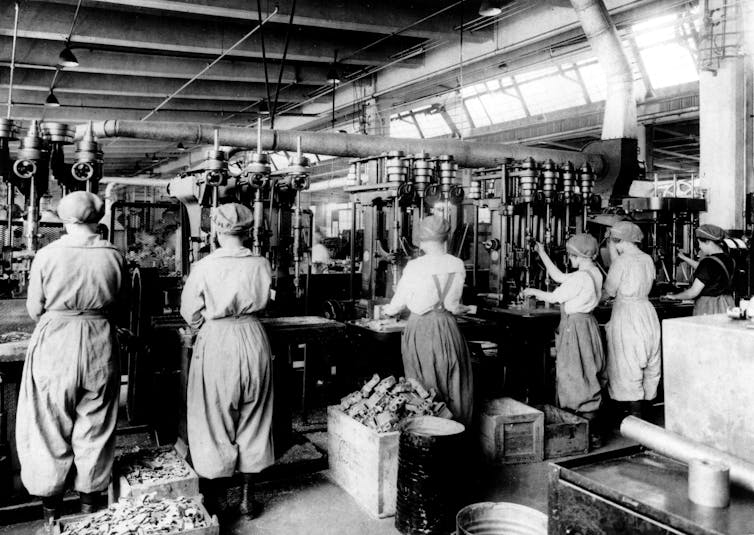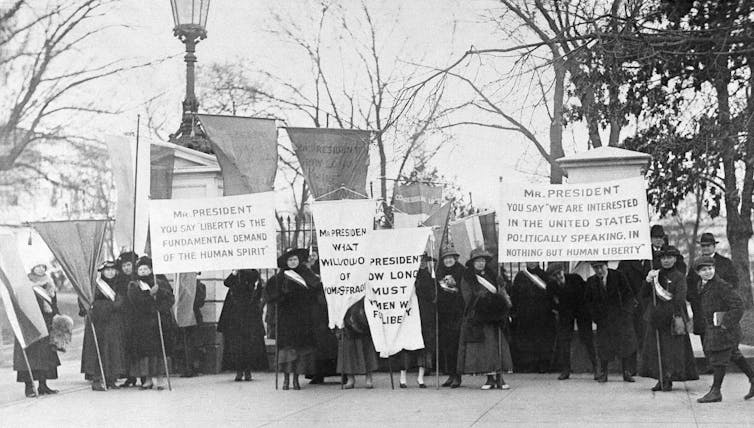How the devastating 1918 flu pandemic helped advance US women's rights
- Written by Christine Crudo Blackburn, Postdoctoral Research Fellow, Scowcroft Institute of International Affairs, Bush School of Government and Public Service, Texas A&M University
When disaster strikes, it can change the fabric of a society – often through the sheer loss of human life. The 2004 Indian Ocean tsunami left 35,000 children[1] without one or both parents in Indonesia alone. The Black Death killed more than 75 million people[2] worldwide and more than a third of Europe’s population[3] between 1347 and 1351.
While disasters are by definition devastating, sometimes they can lead to changes that are a small silver lining. The 2004 tsunami ended a civil conflict in Indonesia[4] that had left 15,000 dead. The 14th century’s plague, probably the most deadly disaster in human history[5], set free many serfs in Europe, forced wages for laborers to rise, and caused a fundamental shift in the economy along with an increased standard of living for survivors.
One hundred years ago, a powerful strain of the flu swept the globe, infecting one third of the world’s population. The aftermath of this disaster, too, led to unexpected social changes, opening up new opportunities for women and in the process irreversibly transforming life in the United States.
The virus disproportionately affected young men, which in combination with World War I, created a shortage of labor. This gap enabled women to play a new and indispensible role in the workforce during the crucial period just before the ratification of the 19th Amendment, which granted women suffrage in the United States[6] two years later.
Why did the flu affect men more than women?
Known as the Spanish flu[7], the 1918 “great influenza” left more than 50 million people dead[8], including around 670,000[9] in the United States.
To put that in perspective, World War I, which concluded just as the flu was at its worst in November 2018, killed around 17 million people – a mere third of the fatalities caused by the flu[10]. More American soldiers died from the flu[11] than were killed in battle, and many of the deaths attributed to World War I were caused by a combination of the war and the flu.
The war provided near perfect conditions for the spread of flu virus via the respiratory droplets exhaled by infected individuals. Military personnel – predominantly young males – spent months at a time in close quarters with thousands of other troops. This proximity, combined with the stress[12] of war and the malnutrition that sometimes accompanied it, created weakened immune systems in soldiers and allowed the virus spread like wildfire.
 When soldiers shipped out, influenza virus could be stowing away onboard.
AP Photo[13]
When soldiers shipped out, influenza virus could be stowing away onboard.
AP Photo[13]
Overcrowding in training camps, trenches and hospitals created an ideal environment[14] for the 1918 influenza strain to infect high numbers of people. In fact, the conditions of war helped the virus perfect itself through several waves of infection[15], each more deadly than the last.
Many troops were doomed before they even reached Europe, contracting the flu on the packed troop ships where a single infected soldier could spread the virus throughout. When soldiers returned to the U.S., they scattered to every state, bringing the flu along with them.
It was more than just male conscription in war, however, that led to a greater number of men who were infected and died from the flu. Even at home, among those that were never involved in the war effort, the death rate for men exceeded that of women[16]. Demographic studies show that nearly 175,000 more men died than women in 1918[17].
In general, epidemics tend to kill more men than women[18]. In disease outbreaks throughout history, as well as almost all of the world’s major famines, women have a longer life expectancy than men and often have greater survival rates[19].
The exact reason why men tend to be more vulnerable to the flu than women continues to elude researchers. The scoffing modern term “man flu” refers to the perception that men are overly dramatic when they fall ill; But recent research suggests that there may be more to it[20] than just exaggerated symptoms.
 The flu’s aftermath furthered a trend started by the war effort.
AP Photo[21]
The flu’s aftermath furthered a trend started by the war effort.
AP Photo[21]
Flu brought more women into the workforce
The severity of the epidemic in the U.S. was enough to temporarily shut down parts of the economy in 1918. In New England, coal deliveries were so severely affected[22] that people, unable to keep their homes heated, froze to death at the height of winter. During the 1918 flu outbreak, researchers estimate businesses in Little Rock, Arkansas, saw a decline of 40 to 70 percent[23].
The worker shortage caused by the flu and World War I opened access to the labor market for women, and in unprecedented numbers they took jobs outside the home. Following the conclusion of the war, the number of women in the workforce was 25 percent higher than it had been[24] previously and by 1920 women made up 21 percent[25] of all gainfully employed individuals in the country. While this gender boost is often ascribed to World War I alone, women’s increased presence in the workforce would have been far less pronounced without the 1918 flu.
Women began to move into employment roles that were previously held exclusively by men[26], many of which were in manufacturing. They were even able to enter fields from which they had been banned, such as the textile industry. As women filled what had been typically male workplace roles, they also began to demand equal pay[27] for their work. Gaining greater economic power, women began more actively advocating for various women’s rights issues – including, but not limited to, the right to vote[28].
 Once a woman’s the boss, how can you deny her the vote?
AP Photo[29]
Once a woman’s the boss, how can you deny her the vote?
AP Photo[29]
How the flu helped change people’s minds
Increased participation in the workforce allowed many women to obtain social and financial independence[30]. Leadership positions within the workforce could now be occupied by women, especially in the garment industry, but also in the military and police forces[31]. The U.S. even got its first woman governor[32], when Nellie Taylor Ross took her oath of office, in 1923, in Wyoming. An increased ability to make decisions in their personal and professional lives empowered many women and started to elevate their standing.
With the war over and increased female participation in the labor force, politicians could not ignore the critical role that women played in American society. Even President Woodrow Wilson[33] began to argue in 1918 that women were part of the American war effort and economy more broadly, and as such, should be afforded the right to vote.
Outside of work, women also became more involved in community decision-making. Women’s changing social role increased support[34] for women’s rights. In 1919, the National Federation of Business and Professional Women’s Clubs was founded. The organization focused on[35] eliminating sex discrimination in the workforce, making sure women got equal pay and creating a comprehensive equal rights amendment.
The 1918 influenza pandemic was devastating. But the massive human tragedy had one silver lining: It helped elevate women in American society socially and financially, providing them more freedom, independence and a louder voice in the political arena.
References
- ^ left 35,000 children (www.theguardian.com)
- ^ killed more than 75 million people (www.livescience.com)
- ^ more than a third of Europe’s population (www.history.com)
- ^ ended a civil conflict in Indonesia (www.worldbank.org)
- ^ probably the most deadly disaster in human history (www.rwjf.org)
- ^ granted women suffrage in the United States (www.loc.gov)
- ^ Known as the Spanish flu (theconversation.com)
- ^ more than 50 million people dead (www.cnn.com)
- ^ 670,000 (www.smithsonianmag.com)
- ^ a mere third of the fatalities caused by the flu (www.bbc.com)
- ^ More American soldiers died from the flu (www.nytimes.com)
- ^ the stress (www.ncbi.nlm.nih.gov)
- ^ AP Photo (www.apimages.com)
- ^ created an ideal environment (www.theguardian.com)
- ^ through several waves of infection (wwwnc.cdc.gov)
- ^ death rate for men exceeded that of women (www.ncbi.nlm.nih.gov)
- ^ 175,000 more men died than women in 1918 (www.ncbi.nlm.nih.gov)
- ^ kill more men than women (www.ncbi.nlm.nih.gov)
- ^ have greater survival rates (www.pnas.org)
- ^ may be more to it (doi.org)
- ^ AP Photo (www.apimages.com)
- ^ coal deliveries were so severely affected (www.cidrap.umn.edu)
- ^ a decline of 40 to 70 percent (www.stlouisfed.org)
- ^ 25 percent higher than it had been (www.american-historama.org)
- ^ women made up 21 percent (www.dol.gov)
- ^ held exclusively by men (www.thoughtco.com)
- ^ demand equal pay (time.com)
- ^ but not limited to, the right to vote (history.house.gov)
- ^ AP Photo (www.apimages.com)
- ^ social and financial independence (www.warandgender.com)
- ^ in the military and police forces (teachersinstitute.yale.edu)
- ^ first woman governor (www.afscme.org)
- ^ Even President Woodrow Wilson (www.nytimes.com)
- ^ increased support (time.com)
- ^ focused on (www.afscme.org)
Authors: Christine Crudo Blackburn, Postdoctoral Research Fellow, Scowcroft Institute of International Affairs, Bush School of Government and Public Service, Texas A&M University

